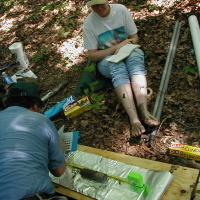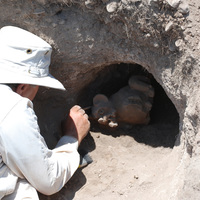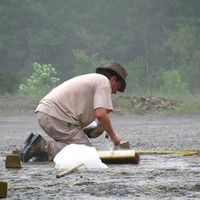Papers by Richard E Michod
The American Naturalist, Nov 1, 1979
Measures of the degree of genetic relationship between individuals are discussed and compared fro... more Measures of the degree of genetic relationship between individuals are discussed and compared from the viewpoint of the theory of kin selection. Limitations of Wright's coefficient of relationship and Hamilton's coefficient of relatedness are discussed. Jacquard's theoretical framework of predicting genic structures is employed in hopes of clarifying the issues involved: (i) measuring genetic relationships between inbred individuals, (ii) the effect of population gene frequency, and (iii) measuring asymmetrical genetic relationships.
The supplementary tables provide the raw data for oligonucleotides, sequence data, meme analyses ... more The supplementary tables provide the raw data for oligonucleotides, sequence data, meme analyses and secondary structures of RNA molecules
The supplementary figures provide details of the experimental protocols and methodologies as well... more The supplementary figures provide details of the experimental protocols and methodologies as well as the raw data for ligation reactions

Biological Theory, 2021
Evolutionary Transitions in Individuality (ETI) have been responsible for the major transitions i... more Evolutionary Transitions in Individuality (ETI) have been responsible for the major transitions in levels of selection and individuality in natural history, such as the origins of prokaryotic and eukaryotic cells, multicellular organisms, and eusocial insects. The integrated hierarchical organization of life thereby emerged as groups of individuals repeatedly evolved into new and more complex kinds of individuals. The Social Protocell Hypothesis (SPH) proposes that the integrated hierarchical organization of human culture can also be understood as the outcome of an ETI—one that produced a “cultural organism” (a “sociont”) from a substrate of socially learned traditions that were contained in growing and dividing social communities. The SPH predicts that a threshold degree of evolutionary individuality would have been achieved by 2.0–2.5 Mya, followed by an increasing degree of evolutionary individuality as the ETI unfolded. We here assess the SPH by applying a battery of criteria—de...
Most of us think of ourselves as individuals. The biological world around us contains a multitude... more Most of us think of ourselves as individuals. The biological world around us contains a multitude of individuals, each of which is composed of many subunits that were separate in the evolutionary past. Some joined to form higher-level units, and others are still separately replicating but joined for life. This marriage

Philosophy, Theory, and Practice in Biology, 2017
While numerous criteria have been proposed in definitions of biological individuality, it is not ... more While numerous criteria have been proposed in definitions of biological individuality, it is not clear whether these criteria reflect the evolutionary processes that underlie transitions in individuality. We consider the evolution of individuality during the transition from unicellular to multicellular life. We assume that "individuality" (however it is defined) has changed in the volvocine green algae lineage during the transition from single cells, to simple multicellular colonies with four to one hundred cells, to more complex multicellular organisms with thousands of differentiated cells. We map traits associated with the various proposed individuality criteria onto volvocine algae species thought to be similar to ancestral forms arising during this transition in individuality. We find that the fulfillment of some criteria, such as genetic homogeneity and genetic uniqueness, do not change across species, while traits underpinning other aspects of individuality, including degrees of integration, group-level fitness and adaptation, and group indivisibility, change dramatically. We observe that different kinds of individuals likely exist at different levels of organization (cell and group) in the same species of algae. Future research should focus on the causes and consequences of variation in individuality.

Journal of theoretical biology, Jan 7, 2017
We develop and compare two models for division initiation in cells of the unicellular green alga ... more We develop and compare two models for division initiation in cells of the unicellular green alga Chlamydomonas reinhardtii, a topic that has remained controversial in spite of years of empirical work. Achieving a better understanding of C. reinhardtii cell cycle regulation is important because this species is used in studies of fundamental eukaryotic cell features and in studies of the evolution of multicellularity. C. reinhardtii proliferates asexually by multiple fission, interspersing rapid rounds of symmetric division with prolonged periods of growth. Our Model 1 reflects major elements of the current consensus view on C. reinhardtii division initiation, with cells first growing to a specific size, then waiting for a particular time prior to division initiation. In Model 2, our proposed alternative, growing cells divide when they have reached a growth-rate-dependent target size. The two models imply a number of different empirical patterns. We highlight these differences alongsi...
Trends in Ecology & Evolution, 1990

Biology & Philosophy, 1991
Our approach to explicating the concept of fitness is to examine the parameters and variables tha... more Our approach to explicating the concept of fitness is to examine the parameters and variables that appear in models used in population biology, how they are interpreted, and what general relationships exist among them. When these models are examined, three general kinds of variables or parameters can be distinguished: rates of increase of genotypes, parameters representing the environment and heritable properties of genotypes. Beginning with R.A. Fisher, the concept of fitness refers to a genotype's rate of increase (F-fitness), which is the bottom line in evolution. As mentioned in our paper, there are other fitness concepts, for example, expected reproductive success, that appear in the models. However, since these concepts are intervening functions used in the calculation of F-fitness we do not belabor them. Maynard Smith notes that F-fitness is not the measure of Darwinian fitness w as expected number of progeny per individual. The terminology can be confusing here, but the bottom line fitness of a genotype which determines expected gene frequency change is F-fitness, which includes the rate of increase due to the genetic system. Why is there a need for general explication of the concept "fitness"? One such need arises from the tortuous discussions of the purported tautology problem by critics of Darwinian evolution. Evolutionists have sometimes been goaded into giving responses which deepen rather than alleviate the confusion. Many evolutionists, however, feel that there is nothing wrong with their actual use of the concept "fitness" (Darwinian fitness, selection coefficients) in their models. Why then should they bother with philosophical analyses of the "real meaning" of 'fitness'? Aside from the notorious tautology challenge there are complexities in interpreting fitness, adaptedness and related concepts due both to ambiguities among different uses of the terms and to subtleties concerning evolutionary explanation. We want some understanding of what various models of evolution

Journal of Phycology, 2010
The volvocine green algal genus Volvox includes 20 species with diverse sizes (in terms of both d... more The volvocine green algal genus Volvox includes 20 species with diverse sizes (in terms of both diameter and cell number), morphologies, and developmental programs. Two suites of characters are shared among distantly related lineages within Volvox. The traits characteristic of all species of Volvox-large (>500) numbers of small somatic cells, much smaller numbers of reproductive cells, and oogamy in sexual reproduction-have three or possibly four separate origins. In addition, some species have evolved a suite of developmental characters that differs from the ancestral developmental program. Most multicellular volvocine algae, including some species of Volvox, share an unusual pattern of cell division known as palintomy or multiple fission. Asexual reproductive cells (gonidia) grow up to many times their initial size and then divide several times in rapid succession, with little or no growth between divisions. Three separate Volvox lineages have evolved a reduced form of palintomy in which reproductive cells are small and grow between cell divisions. In each case, these changes are accompanied by a reduction in the rate of cell division and by a requirement of light for cell division to occur. Thus, two suites of characters-those characteristic of all Volvox species and those related to reduced palintomy-have each evolved convergently or in parallel in lineages that diverged at least 175 million years ago (mya).

The continued well being of evolutionary individuals (units of selection and evolution) depends u... more The continued well being of evolutionary individuals (units of selection and evolution) depends upon their evolvability, that is their capacity to generate and evolve adaptations at their level of organization, as well as their longer term capacity for diversifying into more complex evolutionary forms. During a transition from a lower- to higher-level individual, such as the transition between unicellular and multicellular organisms, the evolvability of the lower-level (cells) must be restricted, while the evolvability of the new higher-level unit (multicellular organism) must be enhanced. For these reasons, understanding the factors leading to an evolutionary transition should help us to understand the factors underlying the emergence of evolvability of a new evolutionary unit. Cooperation among lower-level units is fundamental to the origin of new functions in the higher-level unit. Cooperation can produce a new more complex evolutionary unit, with the requisite properties of heri...

Multicellular organisms probably originated as groups of cells formed in several ways, including ... more Multicellular organisms probably originated as groups of cells formed in several ways, including cell proliferation from a group of founder cells and aggregation. Cooperation among cells benefits the group, but may be costly (altruistic) or beneficial (synergistic) to individual cooperating cells. In this paper, we study conflict mediation, the process by which genetic modifiers evolve that enhance cooperation by altering the parameters of development or rules of forma-tion of cell groups. We are particularly interested in the conditions under which these modifiers lead to a new higher-level unit of selection with increased cooperation among group members and heritable variation in fitness at the group level. By sculpting the fitness variation and opportunity for selection at the two levels, conflict modifiers create new functions at the organism level. An organism is more than a group of cooperating cells related by common descent; organisms require adaptations that regulate confli...

The basic problem in an evolutionary transition in complexity is to understand how a group of ind... more The basic problem in an evolutionary transition in complexity is to understand how a group of individuals becomes a new kind of individual, having heritable variation in fitness at the new level of organization. We see the formation of cooperative interactions among lower-level individuals as a necessary step in evolutionary transitions; only cooperation transfers fitness from lower levels (costs to group members) to higher levels (benefits to the group). As cooperation creates a new level of fitness, it creates the opportunity for conflict between the new level and the lower level. Fundamental to the emergence of a new higher-level individual is the mediation of conflict among lower-level individuals in favor of the higher-level unit. We define a conflict mediator as a feature of the cell-group (the emerging multicellular organism) that restricts the opportunity for fitness variation at the lower level (cells) and/or enhances the variation in fitness at the higher level (the cell-g...
Evolution
Author contributions E.R.H. conceived the project, collected species character data, described st... more Author contributions E.R.H. conceived the project, collected species character data, described strains, performed statistical analyses, and wrote the manuscript; M.D.H. conceived the project and collected species character data; J.J.W. conceived experimental design; H.N. collected species character data; R.E.M. conceived the project; all authors contributed to preparation of the manuscript.

Advances in Marine Genomics, 2015
An evolutionary transition in individuality (ETI) is a fundamental shift in the unit of adaptatio... more An evolutionary transition in individuality (ETI) is a fundamental shift in the unit of adaptation. ETIs occur through the evolution of groups of individuals into a new higher-level individual. The evolution of groups with cells specialized in somatic (viability) or reproductive functions has been proposed as a landmark of the unicellular to multicellular ETI. Several recent models of the evolution of multicellularity and cellular specialization have contributed insights on different aspects of this topic; however, these works are disconnected from each other and from the general framework of ETIs. While each of these works is valuable on its own, our interest in ETIs motivates an attempt to connect these models. We review the theory of ETIs along with these recent models with an eye towards better integrating insights from these models into the ETI framework. We consider how each model addresses key recurring topics, such as the importance of cooperation and conflict, life history trade-offs, multi-level selection, division of labor and the decoupling of fitness at the level of the group from the level of the cell. Finally, we identify a few areas in which conflicting views or unanswered questions remain, and we discuss modeling strategies that would be most suited for making further progress in understanding ETIs.










Uploads
Papers by Richard E Michod